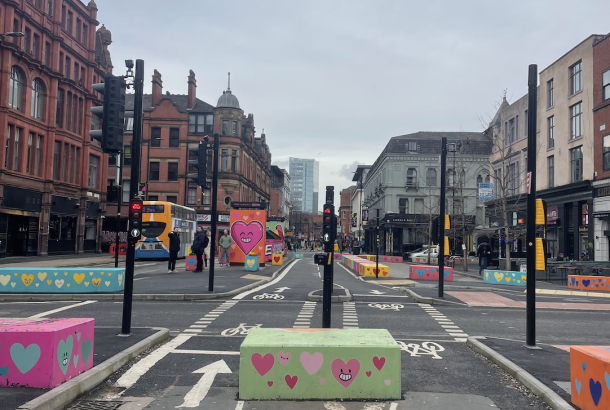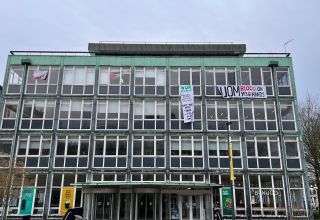How Mayfield Park is turning an abandoned space into a Mancunian heartland
Mayfield Park is Manchester’s first new city-centre park in 100 years. The park was constructed as part of the wider redevelopment of the area, which plans to become a new district in Manchester, rivalling the likes of Ancoates and Northern Quarter.
The Mayfield Partnership was formed in 2016 with the aim to redevelop Mayfield, a disused 24-acre site in the heart of Manchester. The partnership consists of U+I, Manchester City Council, Transport for Greater Manchester, and LCR. The Mancunion spoke to U+I’s PR director, Chris Barry as well as their head of communications, Sam Jarrett to find out more.
One thing made clear was the importance of the local community and the partnership being connected every step of the way during the development of the site. “We can’t learn enough about Mayfield, we can’t learn enough about the local community, and we can’t learn enough about the city,” Chris Barry said when discussing the initial planning of the park. There were also community sessions where the partnership spoke to locals and gathered their thoughts and hopes for the future of Mayfield.
Local school children were invited on trips to the site as well as being consulted on the play equipment that would be built. School children were also invited to try out the ‘Dirt Factory’, a depot turned indoor BMX track. Chris added “incredible to be there to see those kids’ faces” and that those moments are “a really meaningful contribution to a local area.”
Sam spoke of the success the project has had with its community engagement telling us that “the depot and the park really feel like we are resonating with Manchester again as a place.”
Sam also spoke about the future of the depot, which holds events such as Warehouse Project. There is a desire to knock through the depot and connect it to the park to be able to hold events that feel as if they were in the park.
Mayfield Park was formally opened in September 2022 by Bev Craig, leader of Manchester City Council. Sam spoke of his pride when the park first opened describing the thrill of having “created a little bit of green oasis in the middle of an unwelcoming part of the city.” Chris expressed his joy at the fact that “we’d built something that is being used by the people of Manchester and is safe and clean with nature thriving again.”
Nature in the park really is thriving: fish had been spotted in the Medlock returning to the section that had been covered by concrete for more than 50 years and plants have begun to grow for the first time since the 1700s, when the site was first settled as a print-works.
The return of wildlife shouldn’t come as a surprise, one of the key themes that stuck out to me throughout the interview was the aim to be environmentally friendly, something the construction of the Mayfield site has shown throughout. Wells from a brewery previously on the site are being used to water plants; steel beams found when excavating the site have been used to construct new bridges and plans are in place to design nearby office buildings using tiles found from Victorian swimming baths.
When talking about reusing materials found on the site Sam said “A lot of [developers] wince when they find something as they think it’s gonna delay them or cause them a problem. We do anything but that, we try to celebrate it.”
The use of the environment and green space was also shown to be key to the future of Mayfield. Sam told us how they “want people to think of Mayfield Park as part of their back garden and a place that supports and welcomes and nourishes the city.”
Chris felt a “lack of green space was one of the main things holding the city back. It’s interwoven into the fabric of a progressive city that there has to be high-quality green spaces. That can be Mayfield’s legacy.”
The future of Mayfield also contains permanent residents, the first for around 100 years. This new neighbourhood aims to be Manchester’s healthiest, and a hub for “health and wellbeing, music, food and drink, culture, fashion, and technology.” The pair told us how they didn’t want to ascribe values directly to Mayfield as they felt these values would fit best if they developed naturally within Manchester so Mayfield can “feel like it is part of the city as if it’s a district or quarter of Manchester.”
Mayfield’s past is also influencing its future. A building on the site is also named after George Poulton, an exhibitionist at the former swimming baths who used to attempt to popularise the baths when they were seen as unclean in Victorian Britain. The name Mayfield itself is rumoured to come from the wife of Thomas Hoyle, a printworks owner who first settled the site in 1784. There are stories of the section of the Medlock uncovered by the project turning different colours with the offshoots of Hoyle’s factory being sent into the river.
The Mayfield site is only just beginning its new lease of life. There are still residential buildings, office space, and around 700 cycle spaces left to be built in the next stage of the project. The appetite for this development is clear to see as already Mayfield at its most lively state in decades, with the park hosting running and yoga clubs as well as mindfulness classes, on top of its wildlife, green spaces, and play facilities.







